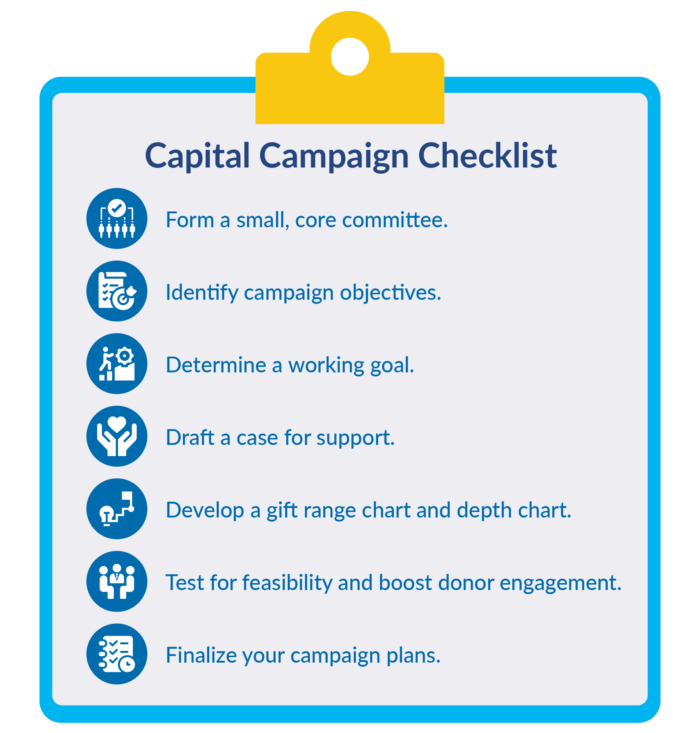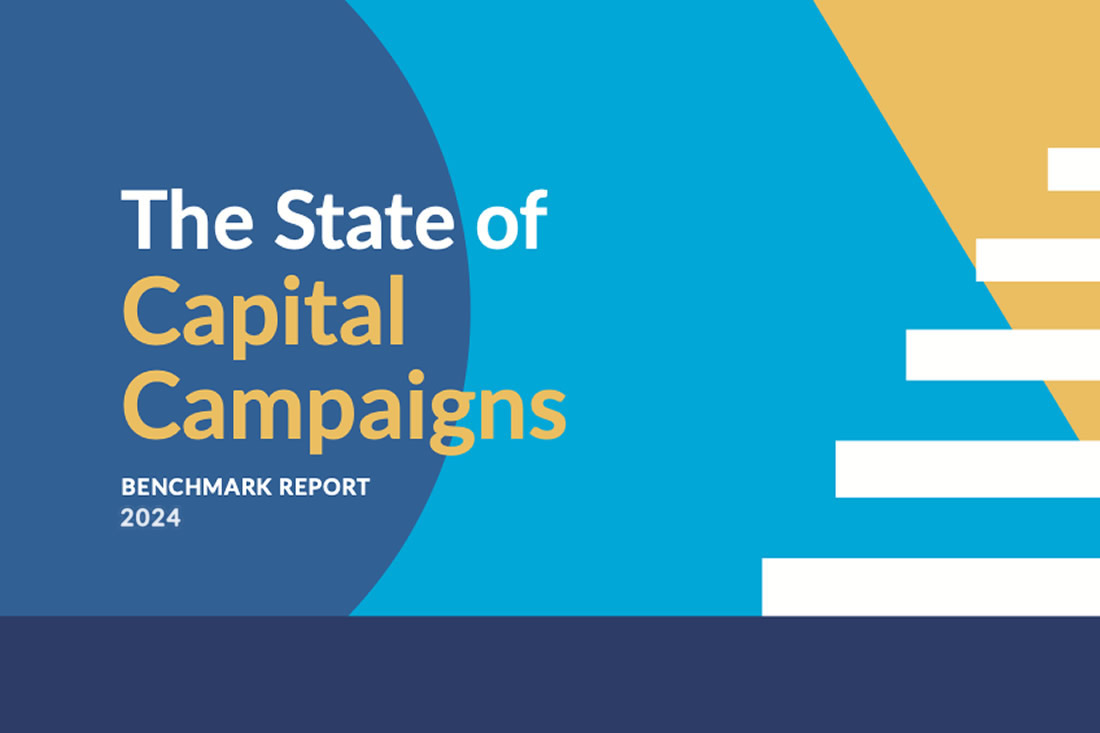Capital Campaign Basics: A 7-Step Checklist for Capital Campaigns

Capital Campaigns can be complicated and overwhelming. But they don’t have to be!
When considering a campaign, you’re likely planning to raise the largest amount your organization has ever tried to raise. That’s scary.
But if you’ve got a big vision for your organization, it’s probably time for a campaign.
Capital Campaign Basics: 7 Key Steps
Use this checklist to calm yourself and your board members. You’ve got this!

Pre-Campaign Planning (Steps 1 to 5)
Generally, campaigns are born from strategic planning processes. Other times, campaigns happen because an organization suddenly needs a new facility (due to an emergency or because their lease gets canceled, etc.)
The board should greenlight some pre-pre campaign planning by approving a strategic plan. Ideally, this plan would include big growth for the organization or acknowledge the need for new facilities, programs, or services.
Step 1: Form a Small, Core Committee
You do not need a large campaign committee at this time. This initial core campaign committee should be comprised of the CEO/ED, Development Director, and a small number of board members.
Note: You may not have selected a campaign chair (or co-chairs) at this point.
Step 2: Identify Campaign Objectives
What do you want to raise funds for? In other words, what do you want to accomplish?
- Will you build or renovate a building?
- Will you expand programs and services?
- Will you increase capacity?
- Will you try something new?
Make a comprehensive list. This is your opportunity to dream big!
Step 3: Determine a Working Goal
To the best of your ability, assign costs to the campaign objectives. This will be your initial working goal.
Determining your working goal may require you to hire an architect to plan and price out the building. You’ll also want to project how much your programs and services will cost when running at full capacity. Here are a few additional tips:
- Plan for new staff (including benefits) for the first three years and include that in your campaign goal.
- Include the systems, infrastructure, and technology which will be necessary for the campaign itself as well as the new programs and services.
- Also include moving and storage costs if you’re moving to a new building.
- Finally, include ten percent for contingency, as well as an additional ten percent for fundraising costs.
Step 4: Draft a Case for Support
Now it’s time to document why donors should care. That’s the essence of your case for support. In other words, why should donors give?
I say “draft” the case for support because you’ll be revising it several times. It shouldn’t be a fancy brochure at this point. Right now, you need a simple 3-page document. Your case for support should explain the impact of the campaign. In other words:
How will the community and the people you serve will be better off after your campaign?
Keep in mind, this is about your future — not about your past. Don’t start with a page of your history. Look to the future! Campaigns look forward, not backward.
Step 5: Develop a Gift Range Chart and Depth Chart
A gift range chart (also known as a gift table or gift pyramid) is the real roadmap for your campaign. It tells you how many gifts you need and in what dollar amounts you need to succeed.
A depth chart shows you who could and might give those gifts. This is where the rubber meets the road. If you don’t have the donors to give these gifts, you may not be able to raise the money you hope to raise.
Feasibility and Campaign Planning (Steps 6 and 7)
You’re now ready to test your pre-campaign plans, engage key leaders and donors, and finalize the primary plan for your campaign.
Step 6: Test for Feasibility and Boost Donor Engagement
Unfortunately, feasibility studies have traditionally been used only to “test” the possibility (or feasibility) of a campaign. But they can (and should be) used for much more than that.
The feasibility study is a unique opportunity to engage donors and leaders in your community by asking them for feedback on your initial campaign plans. Capital Campaign Pro takes a new approach to feasibility studies by supporting nonprofit leaders to interview feasibility study participants — learn more in this 5-minute video.
Step 7: Finalize Your Campaign Plans
Lastly, you’ll want to finalize your campaign plans by incorporating feasibility participant feedback.
Create a complete plan for your campaign utilizing the following components:
- Campaign objectives
- Gift range chart
- Case for support
- A timeline
- Your budget
- Campaign policies
- A donor recognition plan
For templates and samples of campaign plans, consider joining Capital Campaign Pro. You don’t have to reinvent the wheel or wing it — we’ve got your back.
Asking for Gifts – The Quiet Phase
You’re now ready to launch into the quiet phase of your campaign where you’ll raise approximately seventy percent of your campaign goal. Over the next six to eighteen months, you’ll ask for gifts from three key groups:
- Leadership level donors (generally the top 10 to 20 gifts to your campaign)
- Board Members
- Campaign committee members
For more information about how to plan a campaign, check out our free campaign resources. In addition, we’ve got campaign experts standing by ready to answer your questions. Simply sign up for a free strategy session (there’s no obligation).
Have An Expert Assess Your Campaign Readiness
Capital Campaign Pro can review your organization’s readiness in detail. We’ll help identify your strengths — and weaknesses — so you can move forward with confidence.



Leave a Comment